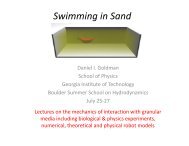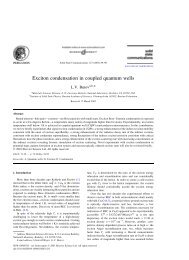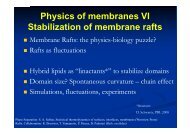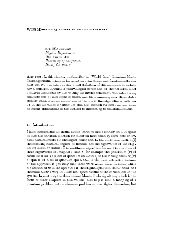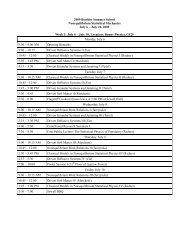Physics of Cooking - Boulder School for Condensed Matter and ...
Physics of Cooking - Boulder School for Condensed Matter and ...
Physics of Cooking - Boulder School for Condensed Matter and ...
You also want an ePaper? Increase the reach of your titles
YUMPU automatically turns print PDFs into web optimized ePapers that Google loves.
<strong>Physics</strong> <strong>of</strong> <strong>Cooking</strong><br />
Dave Weitz<br />
Harvard<br />
Naveen Sinha<br />
Helen Wu<br />
UCB – Public Lecture 7/19/12
The changing world <strong>of</strong> modern cuisine
Jose Andres
Jose Andres
Jose Andres
Ferran Adrià
Ferran Adria<br />
<strong>Cooking</strong> <strong>and</strong> Science
Ferran Adria lecture at Harvard<br />
<strong>Cooking</strong> <strong>and</strong> Science
A science class<br />
Based on cooking
A science class<br />
Based on cooking<br />
Motivated by cooking<br />
But still real science
Michael<br />
Brenner
A team <strong>of</strong> teachers<br />
<strong>Cooking</strong> <strong>and</strong> Science
Wide coverage in the press
The crowds<br />
700 students signed up <strong>for</strong> the class
Mathematics Review<br />
Here is a warm-up: [orders <strong>of</strong> magnitude]
Mathematics Review<br />
Here is a warm-up: [orders <strong>of</strong> magnitude]<br />
Odds <strong>of</strong> getting into SPU 27 300/697= 43%
Mathematics Review<br />
Here is a warm-up: [orders <strong>of</strong> magnitude]<br />
Odds <strong>of</strong> getting into SPU 27 300/697= 43%<br />
Odds <strong>of</strong> getting into Harvard ~ 10%
Mathematics Review<br />
Here is a warm-up: [orders <strong>of</strong> magnitude]<br />
Odds <strong>of</strong> getting into SPU 27 300/670= 44%<br />
Odds <strong>of</strong> getting into Harvard ~ 10%<br />
Odds <strong>of</strong> getting a reservation at El Bulli: 8000/2000000 = 0.5%
Why I took the course
The lab
The lab<br />
Recipe <strong>of</strong> the week
The lab
On Food <strong>and</strong> <strong>Cooking</strong><br />
Harold McGee<br />
This will be the only<br />
required textbook <strong>for</strong> the<br />
course.<br />
Other cookbooks/food<br />
science books are on<br />
reserve.
The Equation <strong>of</strong> the Week<br />
Clap when you see an equation<br />
How <strong>of</strong>ten have you had undergrad<br />
non-science majors<br />
clap every time they see an equation
Bill Yosses
Bill Yosses<br />
White House Pastry Chef
What is cooking
<strong>Cooking</strong> an egg<br />
Liquid Solid
Phases transitions:<br />
A Physicist’s View <strong>of</strong> <strong>Cooking</strong>
Phases <strong>of</strong> water<br />
A macro-scale view<br />
SOLID LIQUID GAS<br />
0 °C 100 °C<br />
Temperature
Phases <strong>of</strong> water<br />
A Micro-scale View<br />
SOLID LIQUID GAS<br />
0 °C 100 °C<br />
Temperature
What is temperature<br />
A scientific definition<br />
Temperature is a measure <strong>of</strong> the energy in the motion <strong>of</strong> the<br />
molecules in the material.
Cook an egg Solidify it<br />
Frozen
Cook an egg Solidify it<br />
Frozen<br />
Boiled
Molecular structure <strong>of</strong> proteins<br />
Assembled<br />
Free Amino Acids<br />
Folded
Protein Denaturation & Coagulation<br />
Coagulation<br />
Denaturation<br />
Forms solid network<br />
Cooked
New ways to cook: Sous Vide
Sous vide eggs<br />
Novel textures are possible at lower temperatures
Phase transitions in food<br />
Egg in temperature-controlled bath<br />
59 °C 61 °C 63 °C 67 °C<br />
Héloïse Vilaseca
What about other parameters<br />
Effect <strong>of</strong> pressure
Effect <strong>of</strong> Pressure<br />
What about other parameters<br />
Pressure at high elevation is greatly reduced:<br />
At 16,000 ft, pressure is 56% <strong>of</strong> that at sea level.
Phases <strong>of</strong> water<br />
Melting/boiling points at different pressures<br />
1.50 atm<br />
1.00 atm<br />
0 °C 112 °C<br />
0.76 atm<br />
0 °C 100 °C<br />
0 °C 92 °C<br />
Temperature
Phases <strong>of</strong> water<br />
Melting/boiling points at different pressures<br />
1.50 atm<br />
1.00 atm<br />
0 °C 112 °C<br />
0.76 atm<br />
0 °C 100 °C<br />
0 °C 92 °C<br />
Temperature
Pressure (atm)<br />
Phases <strong>of</strong> Water<br />
Solid, liquid, <strong>and</strong> gas<br />
5<br />
4.5<br />
4<br />
3.5<br />
3<br />
2.5<br />
2<br />
1.5<br />
1<br />
0.5<br />
0<br />
Solid<br />
Liquid<br />
Gas<br />
-50 0 50 100 150 200 250<br />
Temperature (°C)
Pressure (atm)<br />
Applications <strong>of</strong> the Phase Diagram<br />
St<strong>and</strong>ard Temperature <strong>and</strong> Pressure = STP<br />
5<br />
4.5<br />
4<br />
Solid<br />
3.5<br />
3<br />
Liquid<br />
2.5<br />
2<br />
1.5<br />
Gas<br />
1<br />
0.5<br />
0<br />
-50 0 50 100 150 200 250<br />
Temperature (°C)
Pressure (atm)<br />
Applications <strong>of</strong> the Phase Diagram<br />
High elevation lowers the boiling point<br />
5<br />
4.5<br />
4<br />
Solid<br />
3.5<br />
3<br />
Liquid<br />
2.5<br />
2<br />
1.5<br />
Gas<br />
1<br />
0.5<br />
0<br />
-50 0 50 100 150 200 250<br />
Temperature (°C)
Applications <strong>of</strong> the Phase Diagram<br />
Pressure cookers increase the boiling point
Pressure (atm)<br />
Applications <strong>of</strong> the Phase Diagram<br />
Pressure cookers increase boiling point<br />
5<br />
4.5<br />
4<br />
Solid<br />
3.5<br />
3<br />
Liquid<br />
2.5<br />
2<br />
1.5<br />
Gas<br />
1<br />
0.5<br />
0<br />
-50 0 50 100 150 200 250<br />
Temperature (°C)
Pressure (atm)<br />
Applications <strong>of</strong> the Phase Diagram<br />
Rotary evaporators lower the boiling point<br />
5<br />
4.5<br />
4<br />
Solid<br />
3.5<br />
3<br />
Liquid<br />
2.5<br />
2<br />
1.5<br />
Gas<br />
1<br />
0.5<br />
0<br />
-50 0 50 100 150 200 250<br />
Temperature (°C)
Applications <strong>of</strong> the Phase Diagram<br />
Rotary evaporators lower the boiling point<br />
D Arnold, <strong>Cooking</strong> Issues
Super cool dessert
Super cool dessert
Super cool dessert<br />
Clap when you see a great dessert
Elasticity:<br />
Applications to mouthfeel
Elasticity <strong>of</strong> a spring<br />
Hooke’s Law<br />
F = -kDL<br />
L 0<br />
DL<br />
F<br />
k = - F DL<br />
F = <strong>for</strong>ce [N]<br />
k = spring constant [N/m]<br />
DL = displacement [m]
Elastic constant <strong>of</strong> a material<br />
Intrinsic quantity <strong>of</strong> a material<br />
E = stress<br />
A<br />
F<br />
DL<br />
strain<br />
= F A<br />
DL L 0<br />
L 0<br />
E = Elastic modulus [Pa]<br />
F = Force [N]<br />
A = Area [m 2 ]<br />
DL = change in length [m]<br />
L 0 = initial length [m]
Elasticity <strong>of</strong> a hard-boiled egg
Elasticity <strong>of</strong> a hard-boiled egg
Elasticity <strong>of</strong> a hard-boiled egg
Measurement<br />
Elasticity <strong>of</strong> faux shark fin<br />
We need to measure:<br />
• Force applied<br />
• Area <strong>of</strong> egg<br />
• De<strong>for</strong>mation
Calculation<br />
Elasticity <strong>of</strong> faux shark fin<br />
E<br />
F A<br />
DL / L<br />
0
Calculation<br />
Elasticity <strong>of</strong> hard-boiled egg<br />
E<br />
F A<br />
DL / L<br />
0<br />
Weight used:<br />
Radius <strong>of</strong> egg:<br />
Height <strong>of</strong> egg:<br />
De<strong>for</strong>mation:<br />
1.0 kg<br />
2.0 cm<br />
1.9 cm<br />
0.3 cm
Calculation<br />
Elasticity <strong>of</strong> hard-boiled egg<br />
E<br />
F<br />
F A<br />
DL / L<br />
A<br />
0<br />
2<br />
mg 1.0kg10m s <br />
0<br />
2 2 3 2<br />
<br />
<br />
10N<br />
r 3.14 0.02 1.310 m<br />
DLL<br />
0.3 1.9 0.16
Calculation<br />
Elasticity <strong>of</strong> hard-boiled egg<br />
E<br />
F<br />
F A<br />
DL / L<br />
A<br />
0<br />
2<br />
mg 1.0kg10m s <br />
0<br />
2 2 3 2<br />
<br />
<br />
10N<br />
r 3.14 0.02 1.310 m<br />
DLL<br />
0.3 1.9 0.16
Calculation<br />
Elasticity <strong>of</strong> hard-boiled egg<br />
E<br />
E<br />
F A<br />
D L/<br />
L<br />
0<br />
10N<br />
<br />
3 2<br />
0.161.310 m<br />
4<br />
4.8 10 Pa<br />
E<br />
<br />
48kPa
Calculation<br />
Elasticity <strong>of</strong> hard-boiled egg<br />
E<br />
E<br />
F A<br />
D L/<br />
L<br />
0<br />
10N<br />
<br />
3 2<br />
0.161.310 m<br />
4<br />
4.8 10 Pa<br />
E<br />
<br />
48kPa
Elasticity <strong>of</strong> a cooked steak<br />
Depends on how well cooked it is<br />
Rare<br />
Well-done<br />
E = 45 kPa<br />
E = 63 kPa
Gels<br />
Mainly water
Elasticity <strong>of</strong> a gel<br />
Ex: bouncing gelatin cube (Modernist Cuisine)<br />
http://youtu.be/4n5AfHYST6E
Gel is made from polymers<br />
Chains <strong>of</strong> units or monomers<br />
Alginate from seaweed
Gel are mainly water<br />
But behave like solids
Entropy <strong>of</strong> polymers leads to elasticity<br />
Stretching polymers reduces the number <strong>of</strong> states<br />
Higher entropy<br />
Stored energy = elasticity
Polymers chains <strong>for</strong>m a network<br />
Entangled chains<br />
= polymer str<strong>and</strong>
Polymers can cross-link to <strong>for</strong>m a gel<br />
Form chemical bond where polymers cross<br />
l<br />
= polymer str<strong>and</strong><br />
= permanent bond between<br />
polymer str<strong>and</strong>s
Microscopic view<br />
De<strong>for</strong>mations in the network causes elasticity<br />
L 0 L 0 DL<br />
Long molecules straighten out as the material is stretched.
Equation <strong>of</strong> the week<br />
Elasticity <strong>of</strong> a gel depends on cross-link spacing<br />
E<br />
k B<br />
T<br />
l<br />
E = k B T<br />
l 3<br />
= elasticity [Pa]<br />
= Boltzmann’s constant [J/K]<br />
= temperature [k]<br />
= mesh spacing [m]
Sodium alginate gel<br />
Cross link with calcium<br />
Elasticity is due to the spring-like connections <strong>of</strong> the polymer str<strong>and</strong>s
Spherification:<br />
Diffusion-limited gelation
Spherification: a use <strong>of</strong> gelation<br />
Green pea ravioli / el Bulli <strong>and</strong> Alícia Foundation
Spherification<br />
Yogurt spheres
Spherification: Direct<br />
Alginate drop <strong>for</strong>ms gels with Ca 2+ in solution<br />
Ca 2+ Alginate<br />
Must serve immediately<br />
These can not be stored
Internal view <strong>of</strong> spherification<br />
Shell thickens with time in the Ca 2+ bath<br />
(F. Sapiña y E. Martinez, Universitat de València)
R<strong>and</strong>om walk in two-dimenions<br />
Motion takes much longer because path is longer<br />
Number <strong>of</strong> steps: n<br />
Particle radius: a<br />
Total path length: s<br />
L<br />
L<br />
<br />
n <br />
a <br />
L<br />
<br />
s na a<br />
a <br />
2<br />
2
Diffusion equation<br />
Diffusion time is proportional to distance squared<br />
t<br />
<br />
2<br />
L<br />
D<br />
t = time to diffuse [sec]<br />
L = distance <strong>of</strong> diffusion [m]<br />
D = diffusion coefficient [m 2 /sec]
Time scale <strong>for</strong> spherification<br />
Diffusion <strong>of</strong> Ca 2+ ions in water: D = 7 x 10 -10 m 2 /sec<br />
10 micron shell 100 micron shell<br />
0.1 sec. 10 sec.<br />
t = L2<br />
D = 10´10-6 m<br />
7´10 -10 m 2 s<br />
t = 0.1sec<br />
( ) 2<br />
( ) 2<br />
t = L2<br />
D = 100´10-6 m<br />
7´10 -10 m 2 s<br />
t =10sec
Time scale <strong>for</strong> spherification<br />
Diffusion <strong>of</strong> Ca 2+ ions in water: D = 7 x 10 -10 m 2 /sec<br />
10 micron shell 1 mm shell<br />
0.1 sec. 20 min.<br />
t = L2<br />
D = 10´10-6 m<br />
7´10 -10 m 2 s<br />
t = 0.1sec<br />
( ) 2<br />
t<br />
t<br />
2<br />
L<br />
<br />
D <br />
<br />
<br />
10 3 m 2<br />
10 2<br />
7 10 m s<br />
1000sec<br />
20min
Inverse spherification<br />
Form thin layer <strong>of</strong> gel around droplet
Inverse spherification<br />
Ca 2+ solution <strong>for</strong>ms gels with aqueous alginate<br />
Alginate<br />
Ca 2+ These can be stored
Emulsion:<br />
Mixing oil <strong>and</strong> water
Mayonnaise<br />
Water <strong>and</strong> oil can create a stable emulsion with egg as surfactant
Emulsion: Drops <strong>of</strong> one fluid in another<br />
Dispersed phase<br />
(e.g. oil)<br />
Continuous phase<br />
(e.g. water)
Formation <strong>of</strong> emulsions<br />
Droplets <strong>of</strong> one liquid are <strong>for</strong>med within another.
Formation <strong>of</strong> emulsions<br />
Droplets <strong>of</strong> one liquid are <strong>for</strong>med within another.
Surfactants stabilize emulsions<br />
Surfactants: surface-active molecules<br />
hydrophobic<br />
likes oil<br />
hydrophilic<br />
likes water
Surfactants stabilize emulsions.<br />
Ampiphilic molecules attach to the interfaces.<br />
Microscopic view <strong>of</strong> the interface between drops
Concentrated emulsions are solids<br />
Two liquids mixed together become a solid!<br />
Microscopic view <strong>of</strong> the interface between drops
Emulsions can be solids<br />
Compressed droplets resist de<strong>for</strong>mation.
Elasticity, E<br />
Elasticity as a function <strong>of</strong> f<br />
Emulsions are elastic above critical volume fraction.<br />
( )<br />
E = s R f -f c<br />
f c<br />
f > f c<br />
Volume fraction, f
Elasticity, E<br />
Elasticity as a function <strong>of</strong> f<br />
Emulsions are elastic above critical volume fraction.<br />
( )<br />
E = s R f -f c<br />
f c<br />
f > f c<br />
Volume fraction, f
Foams:<br />
Liquid + Gas = Solid
Example: beer foam<br />
Gas becomes trapped by surfactants in the drink.
Foam production<br />
Incorporate air into fluid<br />
Mix
Foam: Bubbles <strong>of</strong> gas in a liquid<br />
Emulsions with a dispersed phase <strong>of</strong> gas.<br />
Dispersed phase<br />
(air or other gas)<br />
Continuous phase<br />
(e.g. water, cream)
Role <strong>of</strong> surfactants<br />
Proteins, starches, <strong>and</strong> fats can act as surfactants<br />
Water Air Water Air<br />
Lecithin Protein Fat crystal
Foam micro-structure<br />
There are several methods <strong>for</strong> incorporating air.<br />
300 mm<br />
100 mm<br />
10 mm<br />
100 mm
Foam production<br />
Incorporate air into fluid<br />
Mix<br />
Add high-pressure gas
Foam: Mix compressed gas with fluid<br />
Compressed gas is liquid – <strong>for</strong>ms emulsion with fluid<br />
Emulsion <strong>of</strong> compressed<br />
gas in fluid<br />
Foam <strong>for</strong>ms upon release<br />
<strong>of</strong> pressure
Foam production<br />
The resulting products differ in appearance.<br />
KitchenAid<br />
(short time)<br />
iSi Whip<br />
KitchenAid<br />
(long time)
Elasticity, E<br />
Elasticity as a function <strong>of</strong> f<br />
Foams are elastic above critical volume fraction.<br />
( )<br />
E = s R f -f c<br />
f c<br />
f > f c<br />
Volume fraction, f
Elasticity, E<br />
Elasticity as a function <strong>of</strong> f<br />
Foams are elastic above critical volume fraction.<br />
( )<br />
E = s R f -f c<br />
f c<br />
f > f c<br />
Volume fraction, f
Cocktails:<br />
Cooling <strong>and</strong> Dilution
Molecular viewpoint<br />
Ice is in a lower entropy state than water.<br />
Liquid<br />
Ice
Molecular viewpoint<br />
Ice is in a lower energy state than water<br />
Higher energy<br />
Lower energy<br />
Liquid<br />
Ice
Molecular viewpoint<br />
The interface continually exchanges molecules.<br />
Temp.<br />
Water in liquid phase<br />
Water in ice phase<br />
All the water molecules are chemically identical.
Equilibrium: at melting point<br />
The same numbers leave <strong>and</strong> enter the ice.<br />
MP<br />
Temp.<br />
Water in liquid phase<br />
Water in ice phase
Above melting point<br />
More molecules leave the ice.<br />
MP<br />
Temp.<br />
Water in liquid phase<br />
Water in ice phase
Above melting point<br />
More molecules leave the ice.<br />
MP<br />
Temp.<br />
Water in liquid phase<br />
Water in ice phase<br />
Heat is required to melt the ice fluid is cooled
Solutes lower the melting point<br />
Alcohol reduces the equilibrium temperature.<br />
MP<br />
Temp.<br />
Water in liquid phase<br />
Alcohol<br />
Water in ice phase
Heat energy leaves the liquid phase<br />
In a closed system, the temperature decreases.<br />
MP<br />
Temp.<br />
Water in liquid phase<br />
Salt or alcohol<br />
Water in ice phase
Example: Ramos Gin Fizz<br />
Egg whites <strong>and</strong> cream create a stiff foam<br />
2 ounces gin<br />
1 ounce Simple Syrup<br />
1/2 ounce fresh lemon juice<br />
1/2 ounce fresh lime juice<br />
1 ounce heavy cream<br />
1 large egg white<br />
4 drops <strong>of</strong> orange flower water<br />
Ice<br />
1 ounce chilled club soda<br />
Thank you <strong>for</strong> your attention<br />
A. Rosenthal<br />
Food <strong>and</strong> Wine, 2007
Encore:<br />
Ice cream<br />
Foams, emulsions, <strong>and</strong> crystallization
Microscopic structure <strong>of</strong> ice cream<br />
Fat globules are stabilized by proteins<br />
D G<strong>of</strong>f , “Colloidal Aspects <strong>of</strong> Ice Cream” Int. Dairy J. 1997.
Phase diagram <strong>of</strong> salt water<br />
At 0°C, a saltwater solution is super-heated.<br />
Add ice<br />
Salt concentration %<br />
C Clarke, “<strong>Physics</strong> <strong>of</strong> Ice Cream” <strong>Physics</strong> Educ. 2003.







